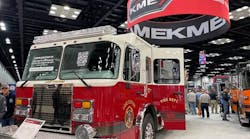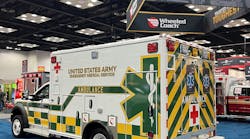The National Fire Protection Association (NFPA) 1901 Standard for Automotive Fire Apparatus has undergone a revision cycle offering changes that will affect contracts signed on or after Jan. 1, 2009, for the purchase of new fire apparatus. Many of these changes are going to affect the way that we drive and operate fire apparatus. The changes include, but are not limited, to vehicle data recorders ("Black Boxes"), vehicle stability (tilt testing), speed limits, better estimated in-service weight, diesel particulate filters, seatbelts, more specific requirements for retro-reflective striping, aerial devices, helmets in the cab and additional equipment on apparatus. Each one of these changes is highlighted in this column.
Vehicle data recorders and associated technology have been around for years. Statistics indicate that an overwhelmingly high percentage of drivers whose actions are questioned have been vindicated by this technology. That is not to say that the remaining drivers have been proven guilty of wrongdoing, but rather that just a small percentage of drivers have had this technology prove some form of guilt in a court of law. There are three components to a vehicle data recorder: the brain that will generally be hidden, the display terminal and an optional handheld data collector.
The data that can be recorded within the system are the vehicle's speed, acceleration and deceleration, engine RPM and throttle position, antilock brake system (ABS) activation, seat occupied with seatbelt status, master optical warning device switch with the master on or off and lateral G-force indicator. All data -- what occurred, where it occurred and when it occurred -- is stored with a date and time stamp and the data is sampled once per second in a 48-hour loop. Vehicle data is sampled minute by minute for 100 engine hours. All data stored in the vehicle data recorder can be uploaded, saved on a computer or printed into hard-copy form. All data stored can be accessed only with a password. Some manufacturers of vehicle data recorders have made available a portable, handheld data-collection unit that can retrieve data from up to 12 vehicles via wireless technology and upload it to a computer via a USB port.
The seatbelt-monitoring component lets the driver and officer know which seats are occupied and which firefighters are seated and secured with seatbelts before moving the vehicle. There is also a built-in output for an external seatbelt alarm system. On the display terminal, which can be viewed by the driver and officer, will be some of the data being sampled. The vehicle data recorder has an optional lateral G-force indicator that alerts the driver and the officer of side forces that are increasing as the vehicle is cornered or operated on a slope or hill. The G-force indicator could help stem the rising tide of fire apparatus rollovers. The visual display will show the vehicle's speed and other system data for the officer to monitor and can also be used when accessing program features. The cab seat indicator shows each seating position and indicates whether seatbelts are properly worn, a seatbelt is unfastened in an occupied seat or a seatbelt is fastened behind a firefighter who is trying to circumvent the system.
Vehicle stability has been addressed in the revision to help combat the high rollover rate of fire apparatus. The standard will require one of the following to enhance vehicle stability: a vehicle stability system (the aforementioned lateral G-force indicator) or the manufacturer can calculate the center of gravity so that it is no higher than 80% of the vehicle's height or do a tilt test on a tilt table so that the vehicle will remain stable to 26.5 degrees in both directions.
Apparatus speed will also be affected. If the gross vehicle weight rating is over 26,000 pounds, the maximum speed will be 68 mph or the fire service speed rating for the vehicle's tires, whichever is lower. If the water and or foam tank capacity is over 1,250 gallons or the gross vehicle weight rating is over 50,000 pounds, the maximum speed is 60 mph or the fire service speed rating for the tires, whichever is lower.
To address the high number of apparatus that have had weight issues in the past, the standard offers a new formula for estimated in-service weight that includes full fluid levels throughout the apparatus, including the water tank or other agents, 250 pounds per firefighter, the chassis, the body, fixed equipment (aerial devices, pumps, etc.), ground ladders, suction hose, hose loads, reels and miscellaneous equipment.
In an apparatus equipped with a diesel particulate filter, the regeneration process must be able to be activated by two methods: the first is automatically by the engine system, if the transmission is in gear and the speedometer is indicating a speed above 5 mph. Second, the system can be activated manually by a dashboard switch. Also, there will be a high exhaust system temperature icon to indicate that the regeneration process has been initiated. As the driver, you will need to have a basic understanding of this system and what it does to be able to identify those parts of the system that will affect you.
With the work that has been done related to ongoing seatbelt research, the standard has changed to account for some of the findings of the studies. Seatbelts can now be bright orange in addition to standard red. Also now required is a seatbelt warning device with an alarm that can be heard throughout the cab and a visual indicator to the driver and/or officer positions as to who has boarded the vehicle and who is seated and belted correctly. The standard defines the length of seatbelts with requirements for how they are measured. The lap belt must be at least 60 inches and the shoulder harness must now be 110 inches to accommodate larger firefighters.
There are now more specific requirements for retro-reflective striping and the material that is used. At least 50% of the rear of an apparatus must have retro-reflective striping in a chevron pattern sloping downward and away from the centerline of the vehicle at an angle of 45 degrees. Each stripe is to be six inches wide and a single color alternating between red and yellow, fluorescent yellow or fluorescent yellow/green. Pump panels are excluded from a 50% side requirement.
Aerial device provisions have changed to allow aerial devices manufactured by builders outside North America to compete in the market. The aerial device must operate at its minimum rated capacity constantly throughout the entire operational range of the device. An aerial device that can be operated over the side when the stabilizers are not fully deployed must be equipped with an interlock to prevent operating the apparatus out of its safe operational range. There must also be an indicator at the operator's position to let the operator determine the maximum extension in relation to the angle of elevation and the extended length of the stabilizers. Changes also allow for electronic controls.
Fire helmets represent another change in the standard. The operator's manual must state that fire helmets shall not be worn by persons riding in an enclosed driving and crew areas. Fire helmets are not designed for crash protection and will interfere with the protection provided by headrests. Furthermore, the manufacturer must provide a location for helmet storage. Visible from each seating position is a label stating, "Do not wear helmet while seated". The minimum seat head-height values in the standard assume that the occupants are not wearing helmets. The use of helmets puts the occupant at greater risk of neck or back injury during a rollover or a severe road event.
Additional equipment that must be on each new apparatus when it is delivered includes one traffic vest for each riding position, five fluorescent-orange traffic cones, five illuminated warning devices, one automatic external defibrillator (AED), and one stepladder or multipurpose ladder can be substituted for a folding ladder if the ladder meets applicable ANSI standards and has duty ratings of 300 pounds or 375 pounds.
Finally, a Statement of Exceptions must be delivered with each new apparatus. The manufacturer must deliver a certification that the apparatus meets the standard or a Statement of Exceptions that describes in detail those items that are not fully compliant and who is responsible to make them compliant. Also, due the needs of the fire service for more trailer-type apparatus, i.e., hazmat, fire prevention and collapse, the standard reflects that change and outlines provisions for those apparatus.
MICHAEL WILBUR, a Firehouse® contributing editor, is a lieutenant in the New York City Fire Department, assigned to Ladder Company 27 in the Bronx, and has served on the FDNY Apparatus Purchasing Committee. He consults on a variety of apparatus-related issues around the country. For further information, access his website at www.emergencyvehicleresponse.com.





